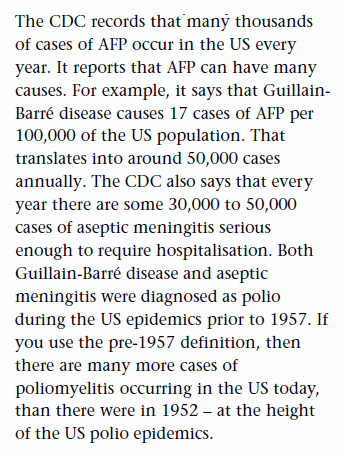|
|
Images Of Poliomyelitis | » plag_home | » jr | » jr_te04p46 |
|
|
Epistemological Disaster(1) |
|
Janine Roberts: The Ecologist Magazine (5/2004, polio article) |
|
Impressive Dissident Discovery
Roberts claims to reveal how, through reclassification, paralytic polio incidence has been concealed since the 1950s. According to Roberts, paralytic polio incidence in the U.S. is actually higher in 2004 (when Roberts' published) than in 1952 (near the apex of The Great Polio Epidemic).
Roberts claims to have found major reclassifications of "paralytic polio", as acute flaccid paralysis (AFP), Guillain-Barre Syndrome (GBS), aseptic meningitis, and West Nile virus disease.

Roberts provides no references. Verification finds...
Roberts' False Claims, Statistics and Concepts
 |
| ● | Roberts falsely interprets GBS as polio ("Infantile Paralysis"). It affects mostly the elderly, and least of all, infants. Neither is GBS a high incidence disease as Roberts claims. |
| ● | Robert falsely lumps together GBS and aseptic meningitis in one sentence. That's talking apples and oranges. Aseptic meningitis is generally benign, not paralytic. |
| ● | Roberts falsely uses the term, "aseptic meningitis", to show reclassification of paralytic polio, yet also employs "aseptic meningitis" elsewhere in the same article to describe reclassification of non-paralytic polio. More bizarre, is that the data is attributed to Jim West. |
| ● | Roberts' concepts and numbers are not in the ballpark. Is Roberts fabricating, incompetent, or is Roberts only concerned with producing an article for payment? |
West Nile Virus ("WNV") Epidemics
This is the next paragraph, where appears to be Roberts mining West's research into West Nile epidemics.
Roberts adds West Nile disease "To This Tally of AFP", continuing with dramatic, vague, unsupported, misleading themes.
Problem 1: Paralytic and non-paralytic disease statistics are mixed.
Problem 2: Age distributions are mixed. Yet polio is fundamentally "Infantile paralysis".
Problem 3: Statistics are not referenced, and verifications finds a profluence of gross errors.
 |
Discussion
Roberts' general topic is an attempt to discuss the reclassification of paralytic polio. If there is any doubt about Roberts' intended topic, see Roberts' relevant discussion with Claus Jensen [ref jr_polio_te04_dem.htm, under construction] where Roberts similarly promotes, "there are more cases of AFP in the US today than there were during the ill-famed polio epidemics."
Roberts' "Hidden Epidemic" is neither virological nor toxicological. It is an epistemological epidemic that has dissidents appearing insane as they try to convey reclassification to others. Roberts has successfully merged dissident trash into orthodox trash. Dissidents espousing Roberts can no longer claim to be proponents of truth.
West is not arguing against reclassification. He believes that faulty reclassifications occur withing every aspect of orthodox disease paradigms, as his polio studies describe. Roberts had removed West's descriptions of reclassification from his own work, while copying that work. Reclassification by misdiagnoses is the central theme of all dissident criticism. Roberts' attempts to describe reclassification appears fabricative, and thus are a dissident hazard.
"Polio" symptoms are indistinguishable from the pollution diseases, common cold, flu, and myriad other diseases with symptoms varying in severity from undetectable symptoms to mortality. The topic "reclassification" cannot be described by mixing apples, oranges and fictional entities.
Beyond this one section, Roberts' article generally has problems, such as references. See other related critiques.
| Footnotes | |
| 1. | Definitions of plagiarism are well stated, and thus apply as an element in a wider discussion. |
| 2. | Guillain-Barre Syndrome (GBS): "Infants appear to have the lowest risk of developing GBS." US incidence is 3 per 100,000. Below age 15 incidence is 1.5 per 100,000. See http://emedicine.medscape.com/article/315632-overview |
| 3. | "GBS occurs in all age groups, although rarely in infants..."; http://www.aafp.org/afp/20040515/2405.html |
| 4. | "[GBS] has an annual incidence of 0.6 to 2.4 cases per 100,000 population and occurs at all ages and in both sexes [2]. The incidence is lower in children, 0.38 and 0.91 cases per 100,000 in two reports"; http://www.uptodate.com/patients/content/topic.do?topicKey=~yXPXqD9E3C2EMW |
| 5. | "[GBS]...virtually full recovery in 70-80% of the patients"; http://www.biomedexperts.com/Abstract.bme/12415961/Guillain-Barre_syndrome_etiology_and_pathogenesis |
| 6. | "Aseptic meningitis is not a nationally notifiable disease, and no nationally accepted case definition exists for this condition." See http://www.cdc.gov/mmwr/preview/mmwrhtml/mm5232a1.htm |
| 7. | "Aseptic meningitis is a benign, self-limiting illness"; http://www.oregon.gov/DHS/ph/acd/diseases/asepticmenin/asepticmenin.shtml |
| 8. | "Two basic patterns of polio infection are described: a minor illness which does not involve the central nervous system (CNS), sometimes called abortive poliomyelitis, and a major illness involving the CNS, which may be paralytic or non-paralytic. [...] Most patients with CNS involvement develop non-paralytic aseptic meningitis, with symptoms of headache, neck, back, abdominal and extremity pain, fever, vomiting, lethargy and irritability. Approximately 1 in 200 to 1 in 1000 cases progress to paralytic disease..."; http://en.wikipedia.org/wiki/Poliomyelitis |
| 9. | "Acute Flaccid Paralysis Surveillance... 2003-2004"; Incidence of non-polio AFP, 1.3 per 100,000 in all the Americas, 1.2 in all of Europe. See http://www.cdc.gov/mmwr/preview/mmwrhtml/mm5347a5.htm |
| 10. | Jim West, "West Nile Virus and Air Pollution" |
| 11. | CDC, West Nile, age distribution, AFP as WNV disease, rarely effects those below age 35: http://www.cdc.gov/ncidod/eid/vol11no07/04-0991-G1.htm |
|
|
Images Of Poliomyelitis | » plag_home | » jr | » jr_te04p46 |
|
©Jim West/HARpub 2009 - All Rights Reserved